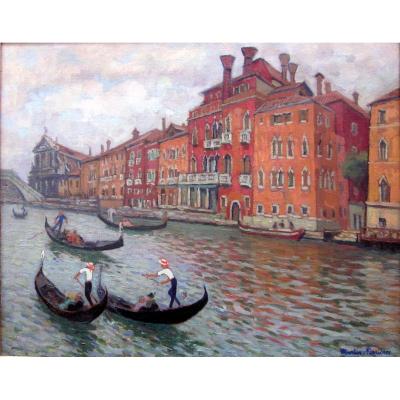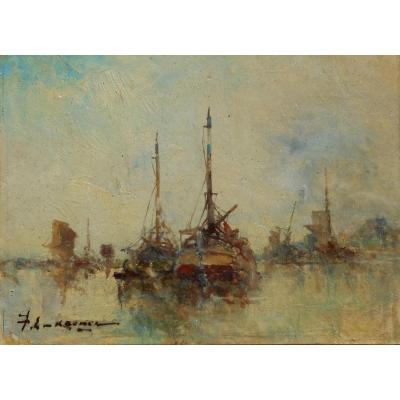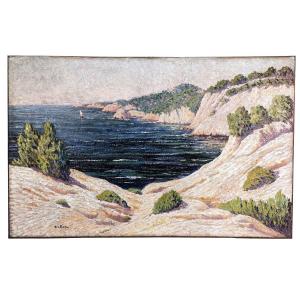From the cold waters of the Baltic to Hudson Bay to the coasts of the East Indies, Dutch ships were everywhere. Carrying everything that the West could not produce, the sailors of the United Provinces contributed to modernity by allowing the development of world trade. Proud of their talents as sailors, the Dutch were keen to celebrate this primacy in the arts, which is what our artist does here.
Under a twilight sky that seems to be on fire, four ships fight against the elements, the one in the center immediately capturing our gaze with the beam of light that illuminates it. The crews strive to keep their boats afloat by lowering their sails. The swell has caused the waves to rise, their white crests crashing against the hulls. In the background is sketched the village of Hoorn, close to the port of Enkhuizen, of which we can see the spire of its Gothic cathedral, Sint-Pancraskerk.
Today unknown, the port of Enkhuizen was very active during the Golden Age, it was the favorite trading port of the East India Company. The progressive silting up of its background and the war against England will cause it to lose its preeminence in favor of Amsterdam. In this regard, Hosftede de Groot lists six original compositions by Ludolf Backhuysen set in the surroundings of Enkhuizen, a sign of the artist's interest in this particular environment. Among these, an original composition dated 1680, currently kept in the Schwerin museum, served as a model for this painting. Beyond minor variations in detail, the two compositions are very similar in execution, likely indicating a workshop replica. Stylistically, this work shows Backhuysen's ability to capture the momentum of a scene. The dramatic tension is formalized by powerful luminous contrasts and bold color schemes. His touch, more vigorous than that of his contemporary Willem van de Velde the Younger, allows him to materialize the agitation of the sea. These qualities earned him fame as one of the greatest marine painters, Houbraken thus recounting that when the storm threatened, Backhuysen regularly decided to sail “towards the heart of the sea, so as to observe the crashing of the waters on the coast and the changes in the weather”.
Our composition is underlined by a powerful 17th century ebonized wooden casseta frame.
Dimensions: 79 x 116 cm the view - 108 x 143 cm with the frame
Sold with invoice and certificate of expertise.
Provenance:
- Collection J. Vay-Dias; Christie's London, 22 April 1932, lot 113, as 'Bakhuysen'.
- Dutch private collection
Biography: Ludolf Backhuysen (Emden 1631 – Amsterdam 1708) was one of the most important marine painters of the Golden Age. However, nothing destined him for such a career. Indeed, as a boy, he worked with his father as a clerk in the Emden City Council and as an accountant in the merchants' guild. He emigrated to Amsterdam in 1649 where he worked as a calligrapher. The young Backhuysen then began to draw and paint grisailles of ships, drawing inspiration from the ink drawings of Willem van de Velde the Elder. Registered with the Amsterdam corporations as a calligrapher and draughtsman, he did not begin oil painting until 1658, learning this medium from Allaert van Everdingen (1621 – 1675) and Hendrik Dubbels (1620 – 1676). He ended up registering with the painters' guild of Amsterdam in 1664, a date from which his success would grow. As a sign of the interest he aroused, the mayor of Amsterdam commissioned him in 1665 for a View of Amsterdam and the Ij (Paris, Louvre) to serve as a diplomatic gift for Louis XIV's minister, Hugues de Lioness. The departure of the van de Velde family for England in 1672 left him the main master of marine painting in Holland. Houbraken even says that the Tsar of all the Russias, Peter the Great, visited him in his studio.
Bibliography:
- DE BEER, Gerlinde, Sein Leben und Werk: Ludolf Nackuysen (1630 – 1708), Zvolle, Waanders Uitgevers, 2002.
- GOEDDE, Lawrence Otto, Tempest and Shipwreck in Dutch and Flemish Art: Convention, Rhetoric, and Interpretation, Park, Pennsylvania State University Press, 1989.
- Ludolf Bakhuizen: 1631-1708, Schryfmeester, Teyckenaer, Schilder (exp. cat. Nederlands Scheep vaart Museum, 1985), Amsterdam, Emden, 1985.
- SCHEELE, Friedrich and Kanzenbach Annette, Ludolf Backhuysen: Emdem 1630 – Amsterdam 1708. Deutscher Kunstverlag 2008.
- RUPERT, Preston, The Seventeenth Century Marine Painters of the Netherlands, F. Lewis Publishers, Leigh-on-Sea, 1974.
- SLIVE, Seymmour, Dutch painting 1600-1800, Yale University Press, 1998.

























 Le Magazine de PROANTIC
Le Magazine de PROANTIC TRÉSORS Magazine
TRÉSORS Magazine Rivista Artiquariato
Rivista Artiquariato
